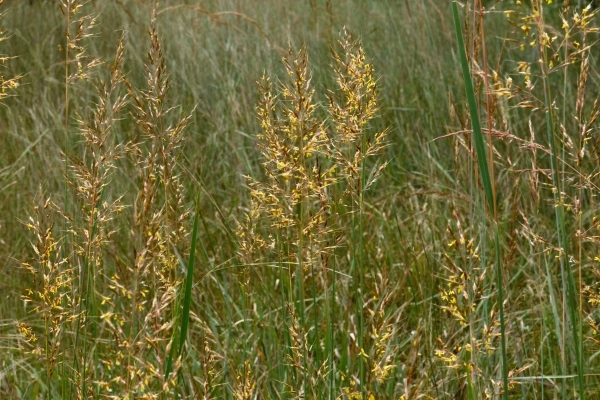
Indian Grass
Botanical Name
:
Sorghastrum nutans
Plant Type
:
Perennial warm-season bunchgrass
Seasons
:
Grows actively in summer, flowers in late summer to early fall
Sun Level
:
Full sun (6+ hours of direct sunlight)
Ideal Soil Temperature for Planting
:
65-75°F (18-24°C)
Soil Type
:
Medium, well-drained soils. Highly adaptable and grows well in various soil types, including shallow rocky soil or less fertile environments
Hardiness Zones
:
3–9 (USDA)
Germination
:
14-30 days. Can benefit from cold stratification and Seed should be planted ½ inch deep or less
P.H. Level
:
4.8 to 8.0
Water/Irrigation
:
Low to moderate, drought-tolerant but grows best with occasional watering in dry seasons
Fertilization
:
This doesn’t require rich soils or frequent fertilization. Avoid fertilizing, as it can result in the roots becoming weak and overly long. Apply fertilizer according to soil test recommendations at establishment, but DO NOT APPLY NITROGEN FERTILIZER during establishment to avoid weed competition
Habit
:
Upright, clumping with arching, blue-green leaves that turn golden in fall
Propagation
:
Replanting established clumps in the spring promotes healthy new growth. Starting seeds indoors and transplanting the seedlings after the last frost is suggested if propagating in cooler temperatures
Final Plant Height
:
3-8 feet (90-243 cm)
Spread
:
2-3 feet (60-90 cm)
Spacing
:
4.5 to 10 lb/acre depending on location and planting method
Flowers
:
Tall, feathery golden-bronze seed heads in late summer, turning reddish in fall
Attracts
:
Birds (seeds in winter) and pollinators
Uses
:
Prairie restoration, ornamental landscaping, erosion control, wildlife habitat, grazing for livestock
Companions
:
Other drought-tolerant plants that thrive in similar conditions, such as coneflowers (Echinacea), little bluestem (Schizachyrium scoparium), or prairie dropseed (Sporobolus heterolepis)
Pruning
:
Reduce the previous year’s growth to about 2-4 inches above the ground in late winter or early spring
Toxicity
:
Non-toxic to humans and pets
Pests
:
Rarely affected by pests but may attract grasshoppers
Diseases
:
Good air circulation around the foliage clump helps prevent fungal diseases during periods of high humidity
Fun Fact
:
The seeds of Indian Grass were historically used as a food source by Native American tribes, and the plant was also used for weaving and thatching
Botanical Name
:
Sorghastrum nutans
Plant Type
:
Perennial warm-season bunchgrass
Seasons
:
Grows actively in summer, flowers in late summer to early fall
Sun Level
:
Full sun (6+ hours of direct sunlight)
Ideal Soil Temperature for Planting
:
65-75°F (18-24°C)
Soil Type
:
Medium, well-drained soils. Highly adaptable and grows well in various soil types, including shallow rocky soil or less fertile environments
Hardiness Zones
:
3–9 (USDA)
Germination
:
14-30 days. Can benefit from cold stratification and Seed should be planted ½ inch deep or less
P.H. Level
:
4.8 to 8.0
Water/Irrigation
:
Low to moderate, drought-tolerant but grows best with occasional watering in dry seasons
Fertilization
:
This doesn’t require rich soils or frequent fertilization. Avoid fertilizing, as it can result in the roots becoming weak and overly long. Apply fertilizer according to soil test recommendations at establishment, but DO NOT APPLY NITROGEN FERTILIZER during establishment to avoid weed competition
Habit
:
Upright, clumping with arching, blue-green leaves that turn golden in fall
Propagation
:
Replanting established clumps in the spring promotes healthy new growth. Starting seeds indoors and transplanting the seedlings after the last frost is suggested if propagating in cooler temperatures
Final Plant Height
:
3-8 feet (90-243 cm)
Spread
:
2-3 feet (60-90 cm)
Spacing
:
4.5 to 10 lb/acre depending on location and planting method
Flowers
:
Tall, feathery golden-bronze seed heads in late summer, turning reddish in fall
Attracts
:
Birds (seeds in winter) and pollinators
Uses
:
Prairie restoration, ornamental landscaping, erosion control, wildlife habitat, grazing for livestock
Companions
:
Other drought-tolerant plants that thrive in similar conditions, such as coneflowers (Echinacea), little bluestem (Schizachyrium scoparium), or prairie dropseed (Sporobolus heterolepis)
Pruning
:
Reduce the previous year’s growth to about 2-4 inches above the ground in late winter or early spring
Toxicity
:
Non-toxic to humans and pets
Pests
:
Rarely affected by pests but may attract grasshoppers
Diseases
:
Good air circulation around the foliage clump helps prevent fungal diseases during periods of high humidity
Fun Fact
:
The seeds of Indian Grass were historically used as a food source by Native American tribes, and the plant was also used for weaving and thatching
Written by Salome Wapukha – https://www.linkedin.com/in/salome-wapukha-556700193/

